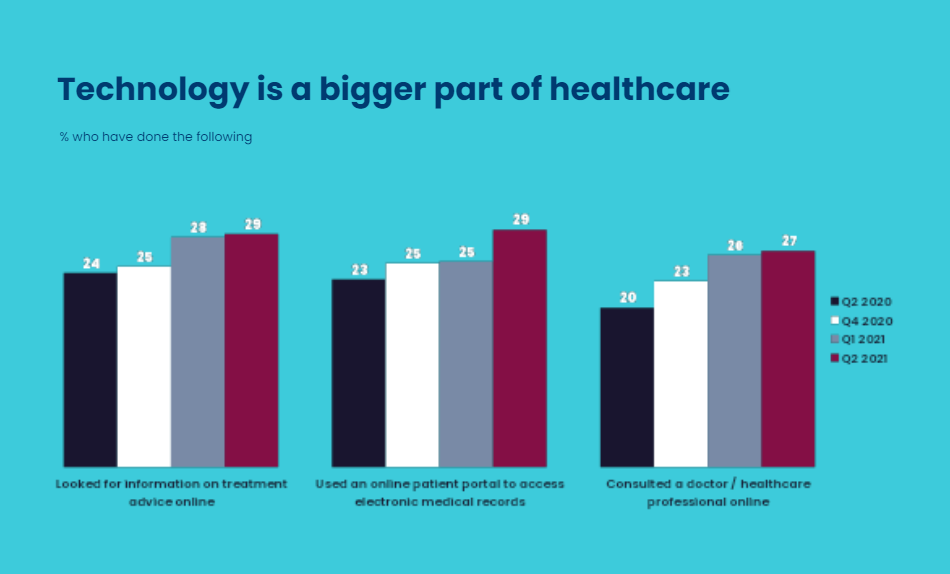Patients are now digital-savvy consumers, forcing the medical sector to shift from B2B to B2C – bringing plenty of opportunities for growth in the process.
By Carrie Seifer, Chief Customer Officer/General Manager, GWI
The pandemic has pushed healthcare tech-based innovation forward by at least a decade. People are now taking their health into their own hands, shifting the entire sector from B2B to B2C – bringing huge opportunities for brands – while investment dollars continue to pour into the sector. In the past quarter alone Walmart bought MeMD and psychology-based digital health platform Noom raised a further $540 million in a Series F round.
Pre-2020, who would have imagined that everyone – including Boomers (don’t discount silver healthtech solutions, they’re growing fast) – would be comfortable with virtual visits to the doctor? Not to mention connected health devices providing remote diagnostics via cloud-based wearables. From filling prescriptions using healthcare portals and reading peer reviews, to comparing prices for treatments and seeking alternative remedies re-packaged for the 21st Century digital-savvy consumer, this is not healthcare as we used to know it.
Consumers, Not Patients
These technology trends and rising costs mean healthcare is quickly becoming a traded commodity. People no longer see themselves as “patients,” at the mercy of the all-powerful and knowledgeable doctor; instead they’re empowered consumers, working in partnership with their primary care providers and accustomed to making smart healthcare choices, with high expectations of digital-first delivery. This opens up the market for both traditional and newer experiential marketing techniques. That’s the good news….
But here’s the bad news:
Isolation and burnout have taken their toll on our individual and collective wellbeing. In our recent GWI research report: A New Wave of Wellbeing: The Rise of Tech-Enabled Healthcare we found that 43 percent of Americans today say “I feel unwell”. Harvard Business Review’s latest look at wellness at work also found that 76 percent of respondents now present with at least one “mental-health-in-decline” symptom.
At GWI, we surveyed our network of 40,000 individuals across 48 markets, and found that 72 percent are “concerned about new Covid-19 variants,” while 39 percent of Gen Z say they “struggle with anxiety Interestingly, Boomers appear to be more resilient than their younger counterparts – or maybe they’re just not as comfortable sharing their feelings. Based on our research, only 16 percent said they were dealing with anxiety – but that’s still north of 7 million people over 60 who don’t feel on top of their game.
It’s important to say we’re not a nation of martyrs. Instead Americans are taking back control, and brands can take advantage of this new consumer behavior pivot in their new messaging to great effect.
Cross-Generational Behavior Pivots
In our report we note that millennials, in particular, are saying “enough is enough”. They’re pushing back against stress, pulling back from social media overload, switching off (AKA digital detoxing), and demanding days off to get back on track. This is a generation that’s learned to set boundaries.
Some employers have formalized these trends by creating “Wellness Days”and other offerings aimed at supporting employee health. In the UK, they’re colloquially known as “Duvet Days.” Look for this broader trend to enter the HR lexicon as the Great Attrition continues. In 2021, employees are seeking employers who show compassion, or they’ll take their talents elsewhere. It’s definitely a good space for brands to play in. Positioning products and services as “Wellness Day Hacks” taps into the zeitgeist and reflects positively on consumer understanding.
Another cross-generational behavior pivot is the normalization of alternative healthcare offerings. During the height of the pandemic, many people were left to fend for themselves medically-speaking. As a result we saw a rise in consumers trying out new nature-based supplements and therapies as an alternative to “Big Pharma”. As this sector grows commercially, keep an eye out for new language like “holistic wellness” rather than “health” when consumers are engaging with brands.
Health-Tech is Here to Stay
None of this would be possible without a digital-first shift in healthcare delivery. You can’t talk about healthcare without talking about tech these days. The proportion of people using technology-based healthcare rose by 33 percent in the past year.

As a result, healthcare has become a B2C sector. Patients have turned into pro-consumers. They’re demanding choice, excellence and price competitiveness, while seeking out consumer-friendly brands. Healthtech disruptors such as Talkspace, hims & hers and Noom are displacing industry incumbents and we expect this trend to continue as people respond positively to products, solutions and experiences that let them streamline and de-stress their lives.
Similarly, they’re turning away from anything that makes it more complicated or painful. It’s time to refresh front-facing user experience tools, while tightening up integration with 3rd parties and keeping a close eye on data privacy.
Finally, providing personal autonomy is crucial. Consumers want to manage their own wellness journey. They want the tools to do this, and will pick brands who speak their language. This shift in healthcare heralds great opportunities, but it’s definitely a B2C game now. Consumers are taking the driver’s seat on the road to getting well – and staying well.





